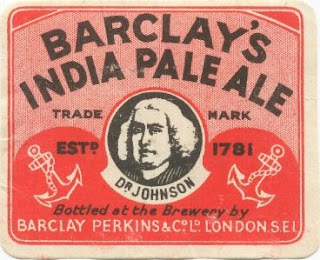By the 1930s, it was all a bit arbitrary if a beer was marketed as IPA or Pale Ale. Much the same as in England. I’ve used my normal system of differentiating between the two: what the brewer called them.
Mostly, they look like the relatively weak Southeastern type, with gravities between 1030º and 1040º. But there are a couple of stronger examples. The two types are different that I’ve split them into separate tables.
Kicking off with the watery stuff.
Mostly, they fall into what was the 5d per pint (on draught) class in England. Beers with a gravity a little short of 1040º. Note the different use of the term 90/-. For some reason in the last couple of decades people have started to use 90/- to refer to Scotch Ale. While before WW II it designated a bottled Pale Ale of fairly modest strength. Neither use makes any real sense.
The examples in the high 1030ºs look like bottled versions of 60/- (or 6d) Pale Ale. The middle of the three different strength Pale ales which most Scottish brewers produced. The weaker ones resemble 54/- (or 5d) Pale Ales, the bottom-strength in the range.
The low gravity and the low rate of hopping, that must have created something almost, but not quite, totally unlike the modern idea of an IPA.
| Scottish Watery IPA before WW II | ||||||
| Year | Brewer | Beer | OG | FG | ABV | App. Atten-uation |
| 1928 | Bernard | 90/- India PA | 1039 | 1005 | 4.43 | 87.18% |
| 1929 | Bernard | India Pale Ale 90/- | 1039.5 | 1009 | 3.96 | 77.22% |
| 1933 | Bernard | India Pale Ale | 1038.5 | 1009.5 | 3.76 | 75.32% |
| 1936 | Jeffrey | India Pale Ale | 1039.5 | 1012.1 | 3.55 | 69.37% |
| 1933 | Murray | India Pale Ale | 1036 | 1010 | 3.37 | 72.22% |
| 1931 | Usher | IPA | 1032 | 1010 | 2.85 | 68.75% |
| 1932 | Usher | India Ale (watered from PA) | 1030.5 | 1008 | 2.92 | 73.77% |
| Average | 1036.4 | 1009.1 | 3.55 | 74.83% | ||
| Sources: | ||||||
| Whitbread Gravity book held at the London Metropolitan Archives, document number LMA/4453/D/02/001. | ||||||
| Thomas Usher Gravity Book document TU/6/11 held at the Scottish Brewing Archive. | ||||||


















































































